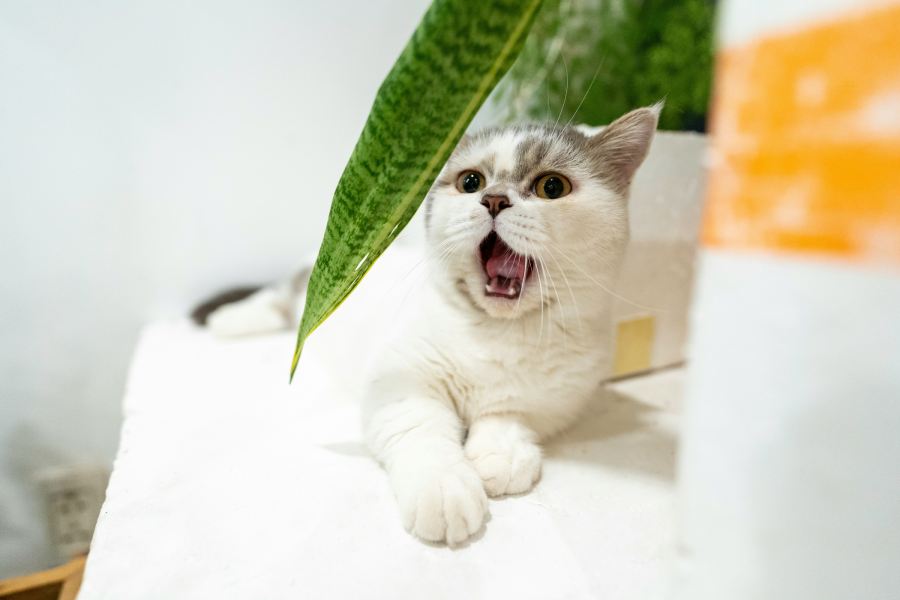Cats are often described as mysterious, but the truth is they are communicating with us constantly through cat body language. Every flick of the tail, twitch of an ear, or narrowing of the eyes tells a story about how they feel in that moment.
The challenge is that cat body language can be subtle and easy to misread. Once you learn what to look for, though, you can understand your cat’s moods more clearly and strengthen your connection with them.
In today’s article, we’ll explore how to read your cat’s body language, what those subtle signals really mean, and how paying attention can lead to a happier, more trusting relationship — especially for pet parents here in Greensboro, where many cats spend time both indoors and exploring screened porches or patios.
Relaxed and Comfortable
A relaxed cat is the picture of contentment. Their body language is soft and open, showing that they feel secure in their space. You might notice them:
- Curling up loosely or stretching out in the open
- Resting with a tail that’s still or gently wrapped around their body
- Slow blinking at you, which is a feline sign of affection and security
If your cat returns your slow blink, it is a wonderful sign that they feel safe and connected to you. Encouraging this quiet exchange of trust builds a stronger relationship over time.
Curious and Playful
When your cat is curious or ready to play, their energy changes completely. Their eyes brighten, their ears tilt forward, and their whiskers relax. A cat in this state may crouch low before a pounce, bat toys with quick movements, or stalk invisible prey across the living room.
Common playful signs include:
- A tail held upright, sometimes curved at the top like a question mark
- Focused eyes and perked ears
- Short bursts of running, jumping, or chasing
Encourage play with wand toys, rolling balls, or interactive puzzles. These activities keep your cat stimulated and mimic natural hunting behaviors, which are important for their overall well-being.
Overstimulated
Many cat parents have experienced moments when their cat seems to enjoy petting one second, then suddenly bites or swats the next. This is not aggression but overstimulation. Cats have a limit to how much physical contact they can tolerate, and when that limit is reached, your cat’s body language gives early warnings.
Watch for signs such as:
- A tail that flicks or twitches quickly
- Ears turning sideways or back
- Pupils that suddenly widen
If you notice these cues, pause the interaction and allow your cat space to relax. This teaches your cat that you respect their boundaries, which helps prevent stress and builds trust over time.
Fearful or Defensive
When a cat feels threatened or afraid, their body language changes dramatically. You may see them crouch low to the ground with their ears flattened and their tail tucked tightly against their body. Some cats puff up their fur to look larger, while others may hiss, growl, or swat to keep a distance.
These are defensive reactions, not signs of a bad temperament. The best response is to give your cat time and space to calm down. Avoid trying to pick them up or comfort them until they have relaxed. Once they feel safe again, gentle reassurance and a calm tone will help restore trust.
Why Understanding Cat Body Language Matters
Learning to interpret your cat’s body language creates a calmer, more connected home. It helps you meet their emotional and physical needs before stress turns into unwanted behavior. When you respond to their cues, you show them they can trust you to understand their feelings.
Understanding your cat’s signals allows you to:
- Recognize when they are happy, playful, or anxious
- Respond in ways that prevent stress or conflict
- Build a deeper, more respectful bond
Over time, you will start to notice the small details that make your cat unique. Every gesture, every sound, and every look adds to their personal way of communicating.
Keeping Cats Happy in Greensboro Homes
The bottom line is that understanding your cat’s body language is the first step toward a calmer, more connected relationship. When you respond to their signals with patience and care, you create an environment where they can truly thrive.
At Top Tails of Greensboro, we believe every cat deserves to feel safe, understood, and loved, even when their owners are away. Our cat sitting and pet care services are designed to provide gentle attention and consistent care so your cat feels at ease in their own home.
If you’re looking for a trusted local team that treats your pets like family, contact Top Tails of Greensboro today to schedule a visit or learn more about our personalized pet sitting services.

Andrea is the founder of Top Tails of Greensboro LLC, a professional pet sitting and dog walking company in Greensboro, NC. She is certified in Pet CPR and First Aid and is a member of Pet Sitters International. Learn more about Andrea!

